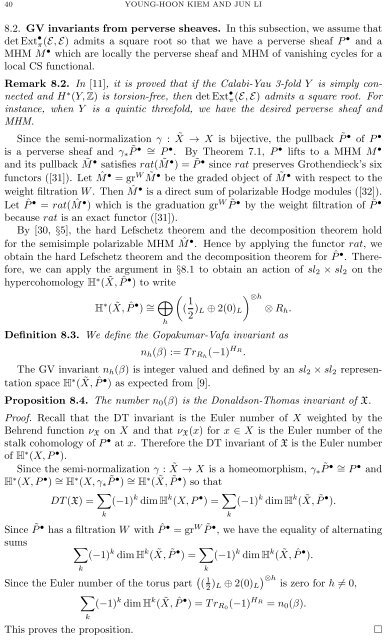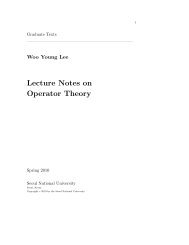40 YOUNG-HOON KIEM AND JUN LI8.2. GV <strong>invariants</strong> from <strong>perverse</strong> sheaves. In this subsection, we assume thatdet Ext • π(E, E) admits a square root so that we have a <strong>perverse</strong> sheaf P • and aMHM M • which are locally the <strong>perverse</strong> sheaf and MHM <strong>of</strong> vanishing cycles for alocal CS functional.Remark 8.2. In [11], it is proved that if the Calabi-Yau 3-fold Y is simply connectedand H ∗ (Y, Z) is torsion-free, then det Ext • π(E, E) admits a square root. Forinstance, when Y is a quintic threefold, we have the desired <strong>perverse</strong> sheaf andMHM.Since the semi-normalization γ : ˜X → X is bijective, the pullback ˜P • <strong>of</strong> P ••is a <strong>perverse</strong> sheaf and γ ∗ ˜P ∼ = P • . By Theorem 7.1, P • lifts to a MHM M •and its pullback ˜M • satisfies rat( ˜M • ) = ˜P • since rat preserves Grothendieck’s sixfunctors ([31]). Let ˆM • = gr W ˜M • be the graded object <strong>of</strong> ˜M • with respect to theweight filtration W . Then ˆM • is a direct sum <strong>of</strong> polarizable Hodge modules ([32]).Let ˆP • = rat( ˆM • ) which is the graduation gr W ˜P • by the weight filtration <strong>of</strong> ˜P •because rat is an exact functor ([31]).By [30, §5], the hard Lefschetz theorem and the decomposition theorem holdfor the semisimple polarizable MHM ˆM • . Hence by applying the functor rat, weobtain the hard Lefschetz theorem and the decomposition theorem for ˆP • . Therefore,we can apply the argument in §8.1 to obtain an action <strong>of</strong> sl 2 × sl 2 on thehypercohomology H ∗ ( ˜X, ˆP • ) to writeH ∗ ( ˜X, ˆP • ) ∼ = ⊕ (( 1 ) ⊗h2 ) L ⊕ 2(0) L ⊗ R h .hDefinition 8.3. We define the Gopakumar-Vafa invariant asn h (β) := T r Rh (−1) H R.The GV invariant n h (β) is integer valued and defined by an sl 2 × sl 2 representationspace H ∗ ( ˜X, ˆP • ) as expected from [9].Proposition 8.4. The number n 0 (β) is the <strong>Donaldson</strong>-<strong>Thomas</strong> invariant <strong>of</strong> X.Pro<strong>of</strong>. Recall that the DT invariant is the Euler number <strong>of</strong> X weighted by theBehrend function ν X on X and that ν X (x) for x ∈ X is the Euler number <strong>of</strong> thestalk cohomology <strong>of</strong> P • at x. Therefore the DT invariant <strong>of</strong> X is the Euler number<strong>of</strong> H ∗ (X, P • ).Since the semi-normalization γ : ˜X → X is a homeomorphism, γ∗ ˜P• ∼ = P • andH ∗ (X, P • ) ∼ = H ∗ (X, γ ∗ ˜P • ) ∼ = H ∗ ( ˜X, ˜P • ) so thatDT (X) = ∑ k(−1) k dim H k (X, P • ) = ∑ k(−1) k dim H k ( ˜X, ˜P • ).Since ˜P • has a filtration W with ˆP • = gr W ˜P • , we have the equality <strong>of</strong> alternatingsums ∑(−1) k dim H k ( ˜X, ˜P • ) = ∑ (−1) k dim H k ( ˜X, ˆP • ).kkSince the Euler number <strong>of</strong> the torus part ( ( 1 2 ) ) ⊗hL ⊕ 2(0) L is zero for h ≠ 0,∑(−1) k dim H k ( ˜X, ˆP • ) = T r R0 (−1) H R= n 0 (β).This proves the proposition.k□
CATEGORIFICATION OF DONALDSON-THOMAS INVARIANTS 41Furthermore, we propose the following conjecture.Conjecture 8.5. (1) The GV <strong>invariants</strong> n h (β) are invariant under deformation<strong>of</strong> the complex structure <strong>of</strong> Y .(2) The GV <strong>invariants</strong> n h (β) depend only on β and are independent <strong>of</strong> the constantterm χ(E) <strong>of</strong> the Hilbert polynomial.(3) The GV <strong>invariants</strong> n h (β) are independent <strong>of</strong> the choice <strong>of</strong> a polarization <strong>of</strong> Y .(4) The identity (8.1) holds.Note that for h = 0, (1) follows from Proposition 8.4 and [35]. Also by [12] and[35], (3) is known for h = 0. Of course, (1)-(3) are consequences <strong>of</strong> (4). Furthermore,establishing the identity (8.1) will equate Definition 8.3 with that introduced byPandharipande-<strong>Thomas</strong> [29] for a large class <strong>of</strong> CY 3-folds (cf. [28]).8.3. K3-fibered CY 3-folds. In this last subsection, we show that Conjecture8.5 holds for a primitive fiber class <strong>of</strong> K3 fibered CY 3-folds.We first consider the local case. We let ∆ ⊂ C be the unit disk, t ∈ Γ(O ∆ ) thestandard coordinate function, and let p : Y → ∆ be a smooth family <strong>of</strong> polarized K3surfaces. We suppose the central fiber Y 0 contains a curve class β 0 ∈ H 1,1 (Y 0 , R) ∩H 2 (Y 0 , Z), not proportional to the polarization, such that β 0 ceases to be (1, 1) inthe first order deformation <strong>of</strong> Y 0 in Y , which means that if we let ˜β ∈ Γ(∆, R 2 p ∗ Z Y )be the continuous extension <strong>of</strong> β 0 and let ˜ω ∈ Γ(∆, p ∗ Ω 2 Y/∆) be a nowhere vanishingsection <strong>of</strong> relative (2, 0)-form, then p ∗ (˜ω ∧ ˜β) ∉ t 2 O ∆ .For c ∈ ∆, we let ι c : Y c → Y be the closed embedding. We let β ∈ H 4 (Y, Z)be such that β 0 = ι ! 0β 0 . Since Y → ∆ is a family <strong>of</strong> polarized K3 surfaces, thefamily <strong>of</strong> relative ample line bundle is ample on Y . We form the moduli M Y (−β, 1)(resp. M Y0 (β 0 , 1)) <strong>of</strong> one dimensional stable sheaves E <strong>of</strong> O Y -modules (resp. O Y0 -modules) with c 2 (E) = −β (resp. c 1 (E) = β 0 ) and χ(E) = 1. Since β is a fiberclass, the moduli M Y (−β, 1) is well defined and is a complex scheme.Because the polarization <strong>of</strong> Y restricts to the polarization <strong>of</strong> Y 0 , we have a closedembedding(8.2) M Y0 (β 0 , 1) −→ ⊂M Y (−β, 1).Lemma 8.6. Suppose β 0 ceases to be (1, 1) in the first order deformation <strong>of</strong> Y 0 inY , and there are no c ≠ 0 ∈ ∆ such that ι ∗ c ˜β ∈ H 1,1 (Y c , R). Then the embedding(8.2) is an isomorphism <strong>of</strong> schemes.Pro<strong>of</strong>. We first claim that for any sheaf [E] ∈ M Y (−β, 1), E = ι 0∗ E ′ for a sheaf[E ′ ] ∈ M Y0 (β 0 , 1). Indeed, let spt(E) be the scheme-theoretic support <strong>of</strong> E. SinceE is stable, it is connected and proper, thus its underlying set is contained in aclosed fiber Y c ⊂ Y for some closed c ∈ ∆. Denoting by the same t ∈ Γ(O Y )the pullback <strong>of</strong> t ∈ O ∆ , since E is coherent, there is a positive integer k so thatspt(E) ⊂ ((t − c) k = 0). In particular, E is annihilated by (t − c) k .Since t − c ∈ Γ(O Y ), multiplying by t − c defines a sheaf homomorphism ·(t − c) :E → E, which has non-tri<strong>via</strong>l kernel since (t − c) k annihilates E. Since E is stable,this is possible only if E is annihilated by t − c. Therefore, letting E ′ = E/(t − c) · E,which is a sheaf <strong>of</strong> O Yc -modules, we have E = ι c∗ E ′ . It remains to show that c = 0.If not, then c 1 (E ′ ) = ι ! cβ will be in H 1,1 (Y c , R), a contradiction. This prove theclaim.We now prove that (8.2) is an isomorphism. Indeed, by the previous argument,we know that (8.2) is a homeomorphism. To prove that it is an isomorphism, we













